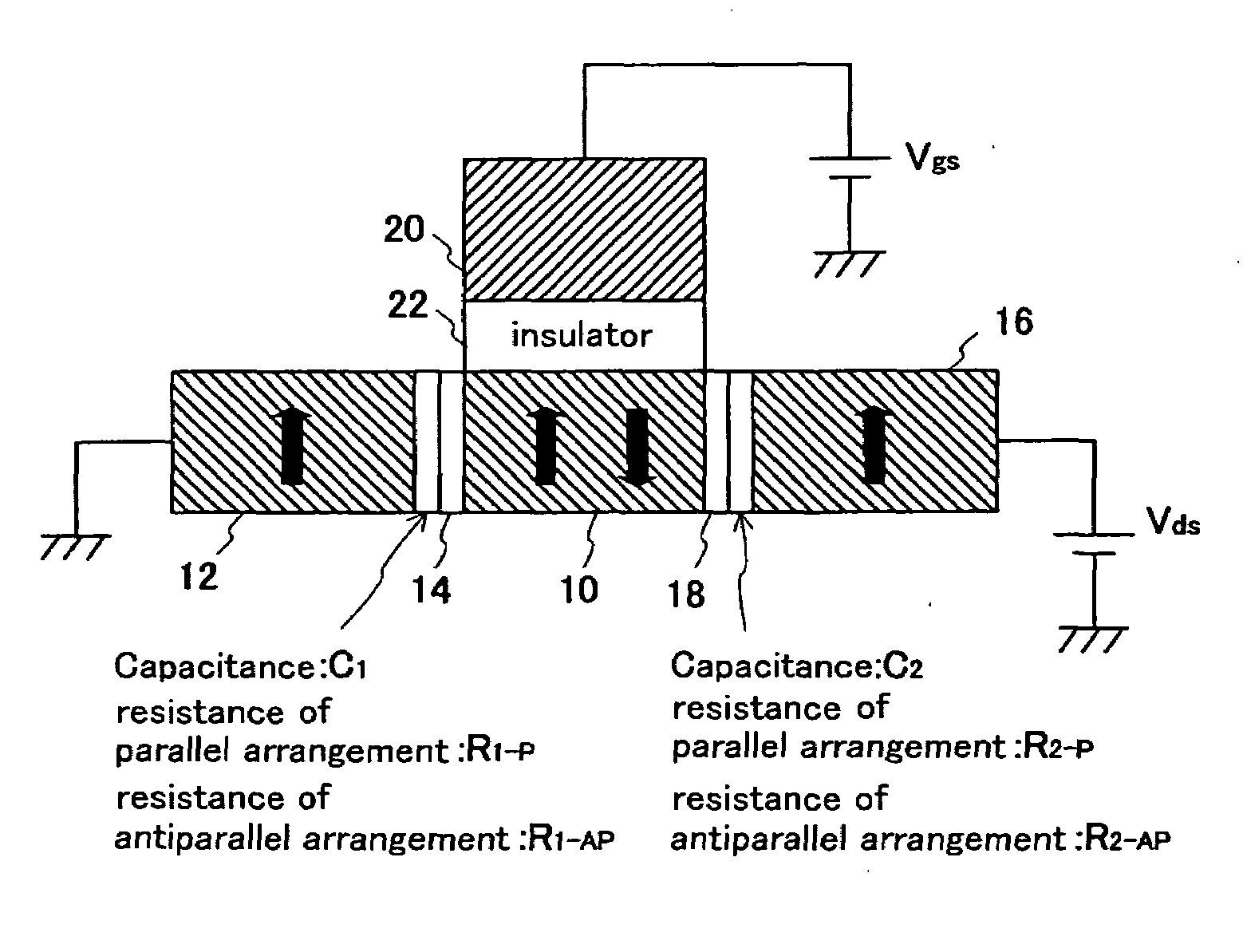Logic Circuit and Single-Electron Spin Transistor
a logic circuit and transistor technology, applied in the field of logic circuits and single-electron spin transistors, can solve the problems of large current consumption and the area of each transistor, large area of logic circuits, and large number of elements, so as to reduce the carrier density, the effect of reducing the power consumption of changing the magnetization direction of the island and facilitating the change of the magnetization direction
- Summary
- Abstract
- Description
- Claims
- Application Information
AI Technical Summary
Benefits of technology
Problems solved by technology
Method used
Image
Examples
first embodiment
[0102]A first embodiment is an example of an inverter circuit that can control the logic threshold value in a nonvolatile manner, by varying the variable magnetization direction of each SEST.
[0103]FIG. 10 shows a circuit diagram of the inverter circuit in accordance with the first embodiment. This inverter circuit (the first inverter circuit) includes a SEST1 (100) and a SEST2 (110). The source 102 of the SEST1 (100) is connected to an output terminal 122, and the drain 104 is connected to a first power supply terminal 128. Tunnel junctions 103 and 105 are provided between an island 101 and the source 102 and between the island 101 and the drain 104, respectively. The tunnel junctions 103 and 105 have capacitance values C2 and C1, resistance values R2-p and R1-p in the parallel arrangement, and resistance values R2-ap and R1-ap in the antiparallel arrangement. A gate 106 is connected to an input terminal 120. A control gate 108 is grounded. The capacitance value of a gate capacitanc...
second embodiment
[0112]A second embodiment is an example of a logic circuit that can reconfigure an OR / AND circuit function using SESTs in a nonvolatile manner. FIG. 13 is a circuit diagram of the logic circuit in accordance with the second embodiment. This logic circuit includes a first inverter circuit (INV1) 190 and a second inverter circuit (INV2) 194. The first inverter circuit (INV1) 190 includes a SEST1 (130) and a SEST2 (140). The INV1 (190) has the same circuit structure and functions as the inverter circuit of the first embodiment, except that a first input terminal and a second input terminal are provided, and an analog input is to be input.
[0113]The structure of the logic circuit is now described in greater detail. The source 132 of the SEST1 (130) is connected to an output terminal 152 of the INV1 (190), and the drain 134 is connected to a first power supply terminal 158. Tunnel junctions 133 and 135 are provided between an island 131 and the source 132 and between the island 131 and th...
third embodiment
[0129]A third embodiment is an example of an asymmetrical logic circuit including SESTs. First, the principles of this embodiment are described. The broken line in FIG. 17 indicates the input / output curve of the inverter circuit of the first embodiment shown in FIG. 11 in a case where the magnetization arrangement of each of the SEST1 (100) and the SEST2 (110) is the parallel arrangement (P). In such a case, the inverter circuit becomes an inverter having a logic threshold value of 0.5.
[0130]In a case where an input is equal to or smaller than “0.5” (V1), the output is greater than “0.5”. When an inverter circuit having an A-D converter function is connected in the next stage, almost “0” can be output. In a case where the input is equal to or greater than “0.5” (V2), the output is smaller than “0.5”. When an inverter circuit having an A-D converter function is connected in the next stage, almost “1” can be output.
[0131]In a case where the magnetization arrangement of the SEST1 (100)...
PUM
 Login to View More
Login to View More Abstract
Description
Claims
Application Information
 Login to View More
Login to View More - R&D
- Intellectual Property
- Life Sciences
- Materials
- Tech Scout
- Unparalleled Data Quality
- Higher Quality Content
- 60% Fewer Hallucinations
Browse by: Latest US Patents, China's latest patents, Technical Efficacy Thesaurus, Application Domain, Technology Topic, Popular Technical Reports.
© 2025 PatSnap. All rights reserved.Legal|Privacy policy|Modern Slavery Act Transparency Statement|Sitemap|About US| Contact US: help@patsnap.com



